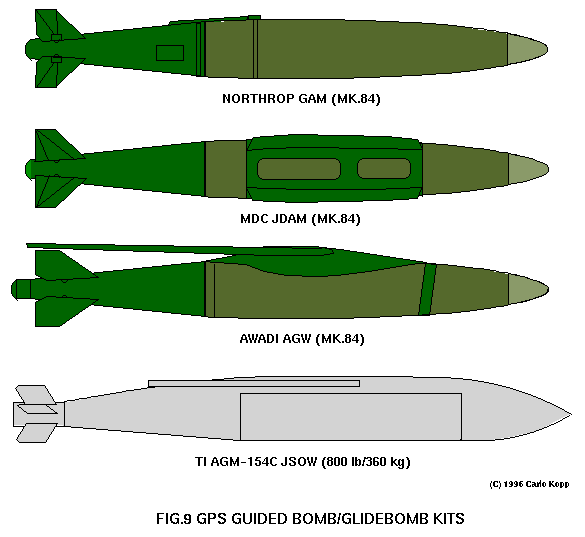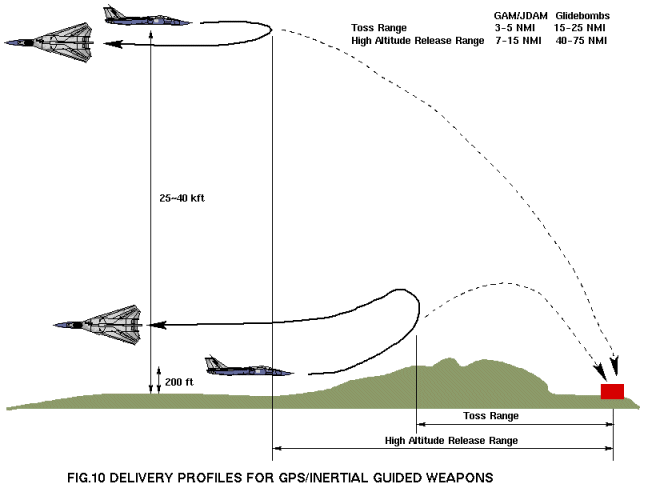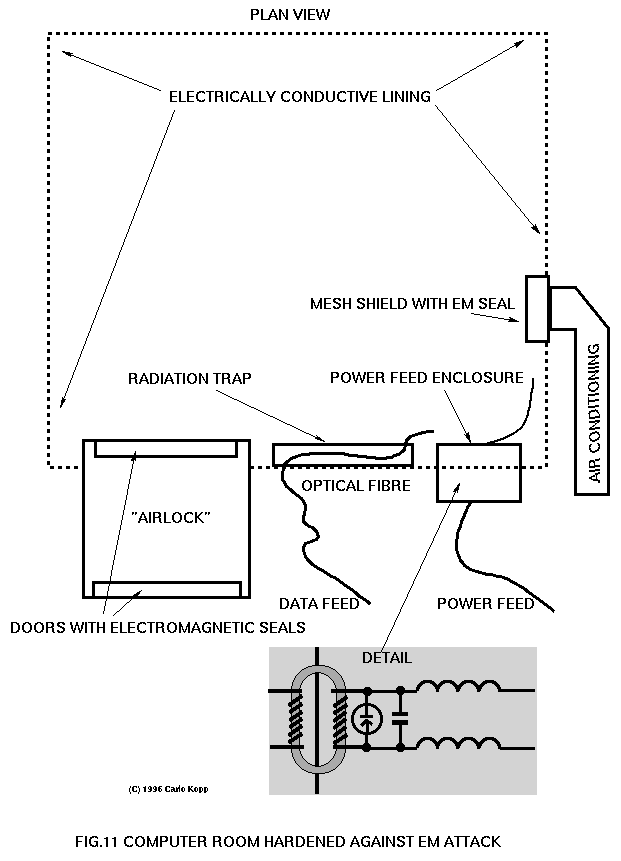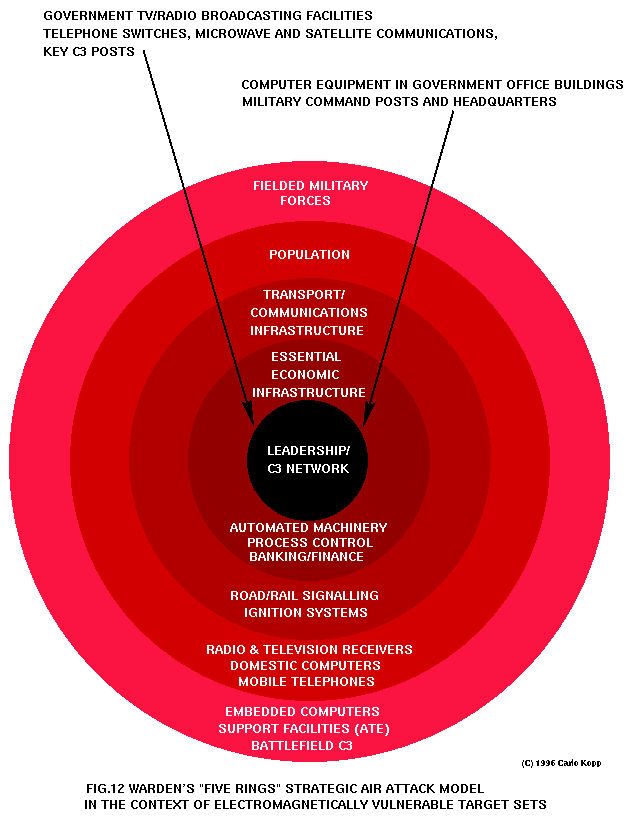| Welcome
To Our "Selected Works of Kurt Saxon & Other Fine Folk" Section |
E-Bombs Part 3 of 4
A good precedent for this targeting paradigm exists. During the SEA (Vietnam) conflict the United States Air Force (USAF) operated a number of night interdiction gun ships which used direction finding receivers to track the emissions from vehicle ignition systems. Once a truck was identified and tracked, the gunship would engage it.

Because
UE occurs at relatively low power levels, the use of this detection method prior
to the outbreak of hostilities can be difficult, as it may be necessary to over fly
hostile territory to find signals of usable intensity. The use of
stealthy reconnaissance aircraft or long range, stealthy Unmanned Aerial
Vehicles (UAV) may be required. The latter also raises the possibility of
autonomous electromagnetic warhead armed expendable UAVs, fitted with
appropriate homing receivers. These would be programmed to loiter in a target
area until a suitable emitter is detected, upon which the UAV would home in and
expend itself against the target.
The
Delivery of Conventional Electromagnetic Bombs
As
with explosive warheads, electromagnetic warheads will occupy a volume of
physical space and will also have some given mass (weight) determined by the
density of the internal hardware. Like explosive warheads, electromagnetic
warheads may be fitted to a range of delivery vehicles.
Known
existing applications involve fitting an electromagnetic warhead to a cruise
missile airframe. The choice of a cruise missile airframe will restrict the
weight of the weapon to about 340 kg (750 lb), although some sacrifice in
airframe fuel capacity could see this size increased. A limitation in all such
applications is the need to carry an electrical energy storage device, e.g. a
battery, to provide the current used to charge the capacitors used to prime the
FCG prior to its discharge. Therefore the available payload capacity will be
split between the electrical storage and the weapon itself.
In
wholly autonomous weapons such as cruise missiles, the size of the priming
current source and its battery may well impose important limitations on weapon
capability. Air delivered bombs, which have a flight time between tens of
seconds to minutes, could be built to exploit the launch aircraft’s power
systems. In such a bomb design, the bomb’s capacitor bank can be charged by
the launch aircraft enroute to target, and after release a much smaller onboard
power supply could be used to maintain the charge in the priming source prior to
weapon initiation.
An
electromagnetic bomb delivered by a conventional aircraft can offer a much
better ratio of electromagnetic device mass to total bomb mass, as most of the
bomb mass can be dedicated to the electromagnetic device installation itself. It
follows therefore, that for a given technology an electromagnetic bomb of
identical mass to a electromagnetic warhead equipped missile can have a much
greater lethality, assuming equal accuracy of delivery and technologically
similar electromagnetic device design.
A
missile borne electromagnetic warhead installation will comprise the
electromagnetic device, an electrical energy converter, and an onboard storage
device such as a battery. As the weapon is pumped, the battery is drained. The
electromagnetic device will be detonated by the missile’s onboard fusing
system. In a cruise missile, this will be tied to the navigation system; in an
anti-shipping missile the radar seeker and in an air-to-air missile, the
proximity fusing system. The warhead fraction (i.e. ratio of total payload
(warhead) mass to launch mass of the weapon) will be between 15% and 30%.
An
electromagnetic bomb warhead will comprise an electromagnetic device, an
electrical energy converter and a energy storage device to pump and sustain the
electromagnetic device charge after separation from the delivery platform.
Fusing could be provided by a radar altimeter fuse to airburst the bomb, a
barometric fuse or in GPS/inertially guided bombs, the navigation system. The
warhead fraction could be as high as 85%, with most of the usable mass occupied
by the electromagnetic device and its supporting hardware.
Due
to the potentially large lethal radius of an electromagnetic device, compared to
an explosive device of similar mass, standoff delivery would be prudent. Whilst
this is an inherent characteristic of weapons such as cruise missiles, potential
applications of these devices to glidebombs, anti-shipping missiles and
air-to-air missiles would dictate fire and forget guidance of the appropriate
variety, to allow the launching aircraft to gain adequate separation of several
miles before warhead detonation.
The recent advent of GPS satellite navigation guidance kits for conventional bombs and glidebombs has provided the optimal means for cheaply delivering such weapons. While GPS guided weapons without differential GPS enhancements may lack the pinpoint accuracy of laser or television guided munitions, they are still quite accurate (CEP \(~~ 40 ft) and importantly, cheap, autonomous all weather weapons.

The
USAF has recently deployed the Northrop GAM (GPS Aided Munition) on the B-2
bomber, and will by the end of the decade deploy the GPS/inertially guided
GBU-29/30 JDAM (Joint Direct Attack Munition)[MDC95] and the AGM-154 JSOW (Joint
Stand Off Weapon) [PERGLER94] glidebomb. Other countries are also developing
this technology, the Australian BAeA AGW (Agile Glide Weapon) glidebomb
achieving a glide range of about 140 km (75 nmi) when launched from altitude.
The
importance of glidebombs as delivery means for HPM warheads is threefold.
Firstly, the glidebomb can be released from outside effective radius of target
air defences, therefore minimising the risk to the launch aircraft. Secondly,
the large standoff range means that the aircraft can remain well clear of the
bomb’s effects. Finally the bomb’s autopilot may be programmed to shape the
terminal trajectory of the weapon, such that a target may be engaged from the
most suitable altitude and aspect.
A
major advantage of using electromagnetic bombs is that they may be delivered by
any tactical aircraft with a nav-attack system capable of delivering GPS guided
munitions. As we can expect GPS guided munitions to be become the standard
weapon in use by Western air forces by the end of this decade, every aircraft
capable of delivering a standard guided munition also becomes a potential
delivery vehicle for a electromagnetic bomb. Should weapon ballistic properties
be identical to the standard weapon, no software changes to the aircraft would
be required.
Because
of the simplicity of electromagnetic bombs in comparison with weapons such as
Anti Radiation Missiles (ARM), it is not unreasonable to expect that these
should be both cheaper to manufacture, and easier to support in the field, thus
allowing for more substantial weapon stocks. In turn this makes saturation
attacks a much more viable proposition.
In
this context it is worth noting that the USAF’s possession of the JDAM capable
F-117A and B-2A will provide the capability to deliver E-bombs against arbitrary
high value targets with virtual impunity. The ability of a B-2A to deliver up to
sixteen GAM/JDAM fitted E-bomb warheads with a 20 ft class CEP would allow a
small number of such aircraft to deliver a decisive blow against key strategic,
air defence and theatre targets. A strike and electronic combat capable
derivative of the F-22 would also be a viable delivery platform for an E-bomb/JDAM.
With its superb radius, low signature and supersonic cruise capability an RFB-22
could attack air defence sites, C3I sites, airbases and strategic targets with
E-bombs, achieving a significant shock effect. A good case may be argued for the
whole F-22 build to be JDAM/E-bomb capable, as this would allow the USAF to
apply the maximum concentration of force against arbitrary air and surface
targets during the opening phase of an air campaign.
Defence
Against Electromagnetic Bombs
The
most effective defence against electromagnetic bombs is to prevent their
delivery by destroying the launch platform or delivery vehicle, as is the case
with nuclear weapons. This however may not always be possible, and therefore
systems which can be expected to suffer exposure to the electromagnetic weapons
effects must be electromagnetically hardened.
The most effective method is to wholly contain the equipment in an electrically conductive enclosure, termed a Faraday cage, which prevents the electromagnetic field from gaining access to the protected equipment. However, most such equipment must communicate with and be fed with power from the outside world, and this can provide entry points via which electrical transients may enter the enclosure and effect damage. While optical fibres address this requirement for transferring data in and out, electrical power feeds remain an ongoing vulnerability.

Where
an electrically conductive channel must enter the enclosure, electromagnetic
arresting devices must be fitted. A range of devices exist, however care must be
taken in determining their parameters to ensure that they can deal with the rise
time and strength of electrical transients produced by electromagnetic devices.
Reports from the US indicate that hardening measures attuned to the behaviour of
nuclear EMP bombs do not perform well when dealing with some conventional
microwave electromagnetic device designs.
It
is significant that hardening of systems must be carried out at a system level,
as electromagnetic damage to any single element of a complex system could
inhibit the function of the whole system. Hardening new build equipment and
systems will add a substantial cost burden. Older equipment and systems may be
impossible to harden properly and may require complete replacement. In simple
terms, hardening by design is significantly easier than attempting to harden
existing equipment.
An
interesting aspect of electrical damage to targets is the possibility of
wounding semiconductor devices thereby causing equipment to suffer repetitive
intermittent faults rather than complete failures. Such faults would tie down
considerable maintenance resources while also diminishing the confidence of the
operators in the equipment’s reliability. Intermittent faults may not be
possible to repair economically, thereby causing equipment in this state to be
removed from service permanently, with considerable loss in maintenance hours
during damage diagnosis. This factor must also be considered when assessing the
hardness of equipment against electromagnetic attack, as partial or incomplete
hardening may in this fashion cause more difficulties than it would solve.
Indeed, shielding which is incomplete may resonate when excited by radiation and
thus contribute to damage inflicted upon the equipment contained within it.
Other
than hardening against attack, facilities which are concealed should not radiate
readily detectable emissions. Where radio frequency communications must be used,
low probability of intercept (i.e. spread spectrum) techniques should be
employed exclusively to preclude the use of site emissions for electromagnetic
targeting purposes. Appropriate suppression of UE is also mandatory.
Communications
networks for voice, data and services should employ topologies with sufficient
redundancy and failover mechanisms to allow operation with multiple nodes and
links inoperative. This will deny a user of electromagnetic bombs the option of
disabling large portions if not the whole of the network by taking down one or
more key nodes or links with a single or small number of attacks.
Limitations
of Electromagnetic Bombs
The
limitations of electromagnetic weapons are determined by weapon implementation
and means of delivery. Weapon implementation will determine the electromagnetic
field strength achievable at a given radius, and its spectral distribution.
Means of delivery will constrain the accuracy with which the weapon can be
positioned in relation to the intended target. Both constrain lethality.
In
the context of targeting military equipment, it must be noted that thermionic
technology (i.e. vacuum tube equipment) is substantially more resilient to the
electromagnetic weapons effects than solid state (i.e. transistor) technology.
Therefore a weapon optimised to destroy solid state computers and receivers may
cause little or no damage to a thermionic technology device, for instance early
1960s Soviet military equipment. Therefore a hard electrical kill may not be
achieved against such targets unless a suitable weapon is used.
This
underscores another limitation of electromagnetic weapons, which is the
difficulty in kill assessment. Radiating targets such as radars or
communications equipment may continue to radiate after an attack even though
their receivers and data processing systems have been damaged or destroyed. This
means that equipment which has been successfully attacked may still appear to
operate. Conversely an opponent may shut down an emitter if attack is imminent
and the absence of emissions means that the success or failure of the attack may
not be immediately apparent.
Assessing
whether an attack on a non radiating emitter has been successful is more
problematic. A good case can be made for developing tools specifically for the
purpose of analysing unintended emissions, not only for targeting purposes, but
also for kill assessment.
An
important factor in assessing the lethal coverage of an electromagnetic weapon
is atmospheric propagation. While the relationship between electromagnetic field
strength and distance from the weapon is one of an inverse square law in free
space, the decay in lethal effect with increasing distance within the atmosphere
will be greater due quantum physical absorption effects. This is particularly so
at higher frequencies, and significant absorption peaks due water vapour and
oxygen exist at frequencies above 20 GHz. These will therefore contain the
effect of HPM weapons to shorter radii than are ideally achievable in the K and
L frequency bands.
Means
of delivery will limit the lethality of an electromagnetic bomb by introducing
limits to the weapon’s size and the accuracy of its delivery. Should the
delivery error be of the order of the weapon’s lethal radius for a given
detonation altitude, lethality will be significantly diminished. This is of
particular importance when assessing the lethality of unguided electromagnetic
bombs, as delivery errors will be more substantial than those experienced with
guided weapons such as GPS guided bombs.
Therefore
accuracy of delivery and achievable lethal radius must be considered against the
allowable collateral damage for the chosen target. Where collateral electrical
damage is a consideration, accuracy of delivery and lethal radius are key
parameters. An inaccurately delivered weapon of large lethal radius may be
unusable against a target should the likely collateral electrical damage be
beyond acceptable limits. This can be a major issue for users constrained by
treaty provisions on collateral damage.
The
Proliferation of Electromagnetic Bombs
At
the time of writing, the United States and the CIS are the only two nations with
the established technology base and the depth of specific experience to design
weapons based upon this technology. However, the relative simplicity of the FCG
and the Vircator suggests that any nation with even a 1940s technology base,
once in possession of engineering drawings and specifications for such weapons,
could manufacture them.
As
an example, the fabrication of an effective FCG can be accomplished with basic
electrical materials, common plastic explosives such as C-4 or Semtex, and
readily available machine tools such as lathes and suitable mandrels for forming
coils. Disregarding the overheads of design, which do not apply in this context,
a two stage FCG could be fabricated for a cost as low as $1,000-2,000, at
Western labour rates. This cost could be even lower in a Third World or newly
industrialised economy.
While
the relative simplicity and thus low cost of such weapons can be considered of
benefit to First World nations intending to build viable war stocks or maintain
production in wartime, the possibility of less developed nations mass producing
such weapons is alarming. The dependence of modern economies upon their
information technology infrastructure makes them highly vulnerable to attack
with such weapons, providing that these can be delivered to their targets.
Of
major concern is the vulnerability resulting from increasing use of
communications and data communications schemes based upon copper cable media. If
the copper medium were to be replaced en masse with optical fibre in order to
achieve higher bandwidths, the communications infrastructure would become
significantly more robust against electromagnetic attack as a result. However,
the current trend is to exploit existing distribution media such as cable TV and
telephone wiring to provide multiple Megabit/s data distribution (e.g. cable
modems, ADSL/HDSL/VDSL) to premises. Moreover, the gradual replacement of
coaxial Ethernet networking with 10-Base-T twisted pair equipment has further
increased the vulnerability of wiring systems inside buildings. It is not
unreasonable to assume that the data and services communications infrastructure
in the West will remain a “soft” electromagnetic target in the foreseeable
future.
At
this time no counter-proliferation regimes exist. Should treaties be agreed to
limit the proliferation of electromagnetic weapons, they would be virtually
impossible to enforce given the common availability of suitable materials and
tools.
With
the former CIS suffering significant economic difficulties, the possibility of
CIS designed microwave and pulse power technology leaking out to Third World
nations or terrorist organisations should not be discounted. The threat of
electromagnetic bomb proliferation is very real.
A
Doctrine for the Use of Conventional Electromagnetic Bombs
A
fundamental tenet of IW is that complex organisational systems such as
governments, industries and military forces cannot function without the flow of
information through their structures. Information flows within these structures
in several directions, under typical conditions of function. A trivial model for
this function would see commands and directives flowing outward from a central
decisionmaking element, with information about the state of the system flowing
in the opposite direction. Real systems are substantially more complex.
This
is of military significance because stopping this flow of information will
severely debilitate the function of any such system. Stopping the outward flow
of information produces paralysis, as commands cannot reach the elements which
are to execute them. Stopping the inward flow of information isolates the
decisionmaking element from reality, and thus severely inhibits its capacity to
make rational decisions which are sensitive to the currency of information at
hand.
The
recent evolution of strategic (air) warfare indicates a growing trend toward
targeting strategies which exploit this most fundamental vulnerability of any
large and organised system. The Desert Storm air war of 1991 is a good instance,
with a substantial effort expended against such targets. Indeed, the model used
for modern strategic air attack places leadership and its supporting
communications in the position of highest targeting priority [WARDEN95]. No less
importantly, modern Electronic Combat concentrates upon the disruption and
destruction of communications and information gathering sensors used to support
military operations. Again the Desert Storm air war provides a good illustration
of the application of this method.
A
strategy which stresses attack upon the information processing and
communications elements of the systems which it is targeting offers a very high
payoff, as it will introduce an increasing level of paralysis and disorientation
within its target. Electromagnetic bombs are a powerful tool in the
implementation of such a strategy.
Electronic
Combat Operations using Electromagnetic Bombs
The
central objective of Electronic Combat (EC) operations is the command of the
electromagnetic spectrum, achieved by soft and hard kill means against the
opponent’s electronic assets. The underlying objective of commanding the
electromagnetic spectrum is to interrupt or substantially reduce the flow of
information through the opponent’s air defence system, air operations
environment and between functional elements of weapon systems.
In
this context the ability of electromagnetic bombs to achieve kills against a
wide range of target types allows their general application to the task of
inflicting attrition upon an opponent’s electronic assets, be they specialised
air defence assets or more general Command-Control-Communications (C3) and other
military assets.
Electromagnetic
bombs can be a means of both soft and hard electrical kill, subject to the
lethality of the weapon and the hardness of its target. A hard electrical kill
by means of an electromagnetic device will be achieved in those instances where
such severe electrical damage is achieved against a target so as to require the
replacement of most if not all of its internal electronics.
Electronic
combat operations using electromagnetic devices involve the use of these to
attack radar, C3 and air defence weapon systems. These should always be attacked
initially with an electromagnetic weapon to achieve soft or hard electrical
kills, followed up by attack with conventional munitions to preclude possible
repair of disabled assets at a later time. As with conventional SEAD operations,
the greatest payoff will be achieved by using electromagnetic weapons against
systems of strategic importance first, followed in turn by those of operational
and tactical importance.
In
comparison with an AntiRadiation Missile (ARM - a missile which homes on the
emissions from a threat radar), the established and specialised tool in the
conduct of SEAD operations, an electromagnetic bomb can achieve kills against
multiple targets of diverse types within its lethal footprint. In this respect
an electromagnetic device may be described as a Weapon of Electrical Mass
Destruction (WEMD). Therefore electromagnetic weapons are a significant force
multiplier in electronic combat operations.
A
conventional electronic combat campaign, or intensive electronic combat
operations, will initially concentrate on saturating the opponent’s electronic
defences, denying information and inflicting maximum attrition upon electronic
assets. The force multiplication offered by electromagnetic weapons vastly
reduces the number of air assets required to inflict substantial attrition, and
where proper electronic reconnaissance has been carried out beforehand, also
reduces the need for specialised assets such as ARM firing aircraft equipped
with costly emitter locating systems.
The
massed application of electromagnetic bombs in the opening phase of an
electronic battle will allow much faster attainment of command of the
electromagnetic spectrum, as it will inflict attrition upon electronic assets at
a much faster rate than possible with conventional means.
Whilst
the immaturity of conventional electromagnetic weapons precludes an exact
analysis of the scale of force multiplication achievable, it is evident that a
single aircraft carrying an electromagnetic bomb capable of concurrently
disabling a SAM site with its collocated acquisition radar and supporting radar
directed AAA weapons, will have the potency of the several ARM firing and
support jamming aircraft required to accomplish the same result by conventional
means. This and the ability of multirole tactical aircraft to perform this task
allows for a much greater concentration of force in the opening phase of the
battle, for a given force size.
In summary the massed application of electromagnetic weapons to Electronic Combat operations will provide for a much faster rate of attrition against hostile electronic assets, achievable with a significantly reduced number of specialised and multirole air assets. This will allow even a modestly sized force to apply overwhelming pressure in the initial phase of an electronic battle, and therefore achieve command of the electromagnetic spectrum in a significantly shorter time than by conventional means.

![]()
